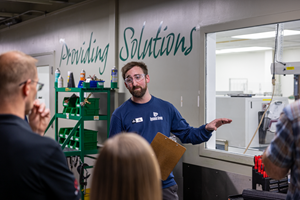Starbucks, Hyatt and Other Major Companies to Eliminate Plastics Straws
Straws are another example of the current laser focus on single-use products, just like the plastic bag.
This week kicked off with plastic straws news: coffee giant Starbucks will eliminate single-use plastic straws from its more than 28,000 company-operated and licensed stores. The company anticipates this will eliminate more than one billion plastic straws per year from Starbucks stores.
Starbucks has designed, developed and manufactured a strawless lid, which will become the standard for all iced coffee, tea and espresso beverages. The lid is currently available in more than 8,000 stores in the U.S. and Canada for select beverages. The lid is also being piloted for beverages in additional markets including China, Japan, Singapore, Thailand and Vietnam.
The lid that is replacing the straw is made from polypropylene. “By nature, the straw isn’t recyclable and the lid is, so we feel this decision is more sustainable and more socially responsible,” says Chris Milne, director of packaging sourcing for Starbucks. “Starbucks is finally drawing a line in the sand and creating a mold for other large brands to follow. We are raising the water line for what’s acceptable and inspiring our peers to follow suit.”
For those who request a straw, Starbucks will offer straws made from alternative materials – including paper or compostable plastic. Starbucks is also encouraging customers to BYOT — “bring your own tumbler” — as part of its efforts to reduce waste. In 2014, Starbucks began selling a $1 reusable cup in the U.S.
Starbucks said it is phasing out single-use plastic straws due to the ocean plastic problem. “Starbucks decision to phase out single-use plastic straws is a shining example of the important role that companies can play in stemming the tide of ocean plastic. With eight million metric tons of plastic entering the ocean every year, we cannot afford to let industry sit on the sidelines, and we are grateful for Starbucks leadership in this space,” says Nicholas Mallos, director of Ocean Conservancy’s Trash Free Seas program.
Starbucks isn’t the only big company eliminating plastic straws due to ocean waste. Starting in September, hotel visitors at Hyatt Hotels will have to request single-use plastic straws and drink picks. “Eco-friendly” alternatives will be provided when available.
“At Hyatt, we care for people so they can be their best, and this care extends to our communities and to preserving resources for future generations. Eliminating plastic straws and drink picks builds on the environmental sustainability programs we have in place and further drives our global efforts to reduce environmental impact,” says Frank Lavey, senior vice president, global operations for Hyatt. “This is a meaningful step, and our commitment doesn’t stop with straws and drink picks. We will continue exploring viable alternatives everywhere we can.”
Royal Caribbean’s cruise ships will also eliminate the use of plastic straws by the end of 2018. That program will be taken a step further by the start of 2019, when guests requesting a straw will receive a paper straw instead of a plastic one. The company says after straws, stirrers and picks, the company's next efforts will focus on other single-use plastics such as condiment packets, cups and bags. A full plastics audit is underway, with the overall plan to be completed in phases by 2020.
According to Bloomberg, the anti-straw movement took off in 2015 when a video of a sea turtle with a straw stuck in its nose when viral.
Straws are another example of the public’s current fixation on single-use products, just like the plastic bag. If you think this issue will go away, it won’t. The public perception of single-use plastics is shifting and not in the direction the industry will necessarily want.
This is why I’m working on a larger article about this topic—plastics straws— so if you’re in the business of plastics straws, plastics recycling, working on recycling design or alternative materials, please reach out to me hcaliendo@gardnerweb.com
Read more about growing efforts to reclaim plastics from the ocean in PT’s July cover story.
Related Content
Medical Tubing: Use Simulation to Troubleshoot, Optimize Processing & Dies
Extrusion simulations can be useful in anticipating issues and running “what-if” scenarios to size extruders and design dies for extrusion projects. It should be used at early stages of any project to avoid trial and error and remaking tooling.
Read MoreMedical Molder, Moldmaker Embraces Continuous Improvement
True to the adjective in its name, Dynamic Group has been characterized by constant change, activity and progress over its nearly five decades as a medical molder and moldmaker.
Read MoreUS Merchants Makes its Mark in Injection Molding
In less than a decade in injection molding, US Merchants has acquired hundreds of machines spread across facilities in California, Texas, Virginia and Arizona, with even more growth coming.
Read MorePHA Compound Molded into “World’s First” Biodegradable Bottle Closures
Beyond Plastic and partners have created a certified biodegradable PHA compound that can be injection molded into 38-mm closures in a sub 6-second cycle from a multicavity hot runner tool.
Read MoreRead Next
Making the Circular Economy a Reality
Driven by brand owner demands and new worldwide legislation, the entire supply chain is working toward the shift to circularity, with some evidence the circular economy has already begun.
Read MorePeople 4.0 – How to Get Buy-In from Your Staff for Industry 4.0 Systems
Implementing a production monitoring system as the foundation of a ‘smart factory’ is about integrating people with new technology as much as it is about integrating machines and computers. Here are tips from a company that has gone through the process.
Read MoreBeyond Prototypes: 8 Ways the Plastics Industry Is Using 3D Printing
Plastics processors are finding applications for 3D printing around the plant and across the supply chain. Here are 8 examples to look for at NPE2024.
Read More

























